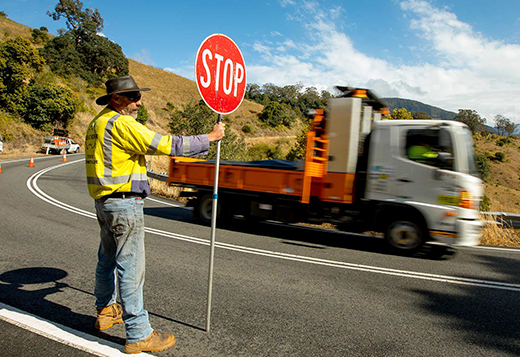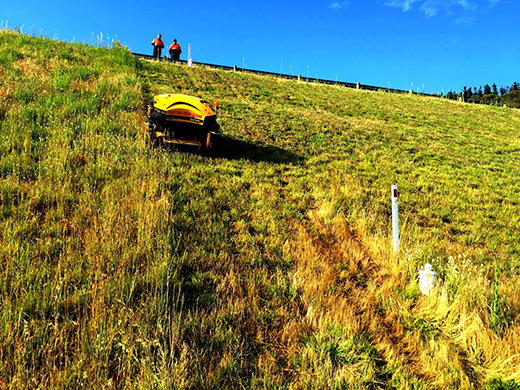
Civiline Specialist Commercial Mowers
Solving Industry Challenges
SAFETY AND PRODUCTIVITY |
|
The emphasis on workplace health and safety, and the need to improve productivity, continue to apply pressure to the profession. Zero-turn mowers revolutionised the productivity of mowing flat open areas. But mowing on slopes has hazards that need new mowing systems. It is a trap to progressively push the use of zero-turn mowers into ever increasing slopes with the potential for disaster.
Working on slopes with cut vegetation presents a daily hazard for operators, increasing the risk of slips and falls, particularly when using manual cutting methods such as brushcutters.
Fatigued operators are more likely to make poor decisions relating to traffic risks, slips and falls, diligent use of PPE, overlooking site hazards, re-fuelling and so on. Safety and productivity are not necessarily competing imperatives. With the right technology, they are complementary. | |
|
SAFETY RISKS OF SLOPE MOWING
| |
PRODUCTIVITY AND COSTS |
|
|
Traffic management, lane calming, setup and pull-down costs can all turn a simple mowing job into a high cost activity with the need for additional labour and vehicles. Some high traffic roads cannot accommodate lane downtime during daylight hours so work is scheduled as night work, further increasing labour and operational costs. Small footprint machines, with the operator remote from the situation, bring many benefits in operational and capital costs. PRODUCTIVITY and COSTS
|
|
CLIMATE CHANGE |
Solar farms need ground-cover vegetation to manage dust and heat on the PV cells. But the low PV panel height and tight rows create new challenges for mowing equipment. Weather extremes of long periods of dry and heavy deluges of rain will continue to affect exposed infrastructure such as roads, dams, waterways, levee banks and so on.
Economic slope stabilisation can be achieved with a healthy grass cover. Mowing promotes healthy grass regrowth and reduces weeds that can shadow grass and eventually create exposed dead zones susceptible to erosion.
The demand to maintain vegetation that could ignite after prolonged dry spells, affecting nearby infrastructure or residential and commercial areas, will only increase with climate change. This includes new areas that have been uneconomical to maintain in the past. |
CLIMATE CHANGE
|
|





 Agria LT 9600 Slope Mower.jpg)
 Agria LT 9600 Slope Mower.jpg)
 Agria LT 9600 Slope Mower.jpg)
 Agria LT 9600 Slope Mower.jpg)
 Spider Remote-Controlled Mower.jpg)
 Spider Remote-Controlled Mower.jpg)
 Spider Remote-Controlled Mower.jpg)
 Spider Remote-Controlled Mower.jpg)
 Track 50 Remote-Controlled Mower.jpg)
 Track 50 Remote-Controlled Mower.jpg)
 Track 50 Remote-Controlled Mower.jpg)
 Track 50 Remote-Controlled Mower.jpg)
 Commercial mowing contractors are being challenged to find innovative solutions to remain productive, competitive and safe while meeting new customer needs and increasing expectations.
Commercial mowing contractors are being challenged to find innovative solutions to remain productive, competitive and safe while meeting new customer needs and increasing expectations.
 The solution is to remove the operator from machines at risk of rollover. Remote-control technology has become the solution of choice.
The solution is to remove the operator from machines at risk of rollover. Remote-control technology has become the solution of choice. Fatigue from working in heat and on slopes with substantial manual handling is an occupational health and safety issue as well as a productivity factor.
Fatigue from working in heat and on slopes with substantial manual handling is an occupational health and safety issue as well as a productivity factor. Mowing labour productivity is important, but so are the other support costs that apply in situations such as roadside mowing.
Mowing labour productivity is important, but so are the other support costs that apply in situations such as roadside mowing. Climate change is creating new mowing needs and increasing the demands on infrastructure maintenance.
Climate change is creating new mowing needs and increasing the demands on infrastructure maintenance.
 Dam walls have been the source of many disasters globally, and maintenance of the integrity of dam wall surfaces is important.
Dam walls have been the source of many disasters globally, and maintenance of the integrity of dam wall surfaces is important. Water management and storage will continue to face increasing demands and public expectations as a solution to climate change, whether for water consumption or for hydro-electric purposes.
Water management and storage will continue to face increasing demands and public expectations as a solution to climate change, whether for water consumption or for hydro-electric purposes.